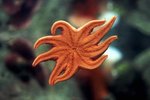
Most people are familiar with and wary of the tentacles on a jellyfish, but not everyone could name and define the fuzzy part of the jellyfish that trails away from the body next to those tentacles. These fuzzy things, which some people may mistake for additional tentacles, are actually a jellyfish’s oral arms.
Jellyfish Anatomy
Jellyfish are relatively simple life forms with three basic parts: the bell, the tentacles and the oral arms. The bell is the half-moon-shaped portion of the jellyfish. This bell is ringed with muscles which jellyfish can tighten and relax in order to help propel them through the water. The tentacles hang down from the bell and have stinging organs to stun the jellyfish’s prey. In addition to the tentacles, jellyfish have four to eight oral arms. These oral arms are more or less defined depending on the type of jellyfish.
The Purpose of the Oral Arms
The highly-branched oral arms of the jellyfish are located near his mouth, which is on the underside of the bell. Once jellyfish stun and capture their food with their tentacles, they use their oral arms to draw that food up to their mouths. In addition to helping jellyfish consume larger prey that gets caught in their tentacles, the oral arms can help sweep plankton into the mouths of jellyfish.
Are Oral Arms Toxic?
Because some jellyfish can sting humans with their tentacles, swimmers and beachgoers may also be concerned about the oral arms. Many jellyfish do have both oral arms and tentacles that are coated in nematocysts, a type of venomous cell. These nematocysts are activated when touched and will inject toxin into the jellyfish’s unsuspecting prey. However, most types of jellyfish do not have enough toxin in their oral arms or tentacles to seriously harm humans, and the majority of stings will result in only mild discomfort.
In Case of Emergency
If you are stung by a jellyfish, remove the tentacles and oral arms from your body, as these structures can continue emitting venom even if they’ve become detached from the jellyfish. Get out of the water as soon as possible and treat the sting with basic first aid. If the sting seems more serious and the swelling or pain does not go away within a few minutes, seek medical attention.
References
Photo Credits
-
Jupiterimages/Photos.com/Getty Images
Writer Bio
Juliana Weiss-Roessler has been writing since 2000. She worked as the head of the Web content department for the star of an Emmy-nominated reality series. Her ghostwriting has appeared in "PARADE" and "People." Weiss-Roessler is a blogger for Resumark and an editor for Pink Raygun. She has a Bachelor of Arts in English from the University of Florida.




